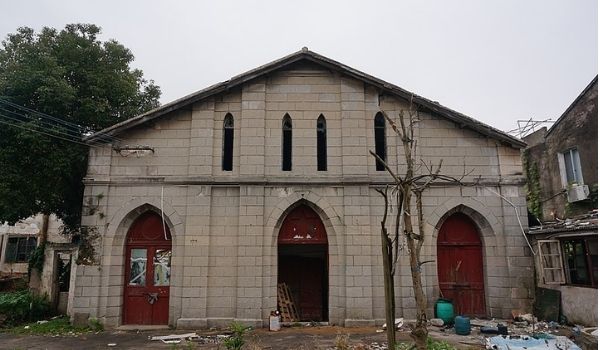
Haimen, in eastern China Jiangsu province, is located 1,012 kilometers southeast of Beijing, at the opposite side of the Yangtze River to Shanghai. It has a land size of more than 1,000 square kilometers. The city was the seat of the Roman Catholic Diocese of Haimen. In the early 1980's, the cathedral was moved to Nantong, about 50 kilometers northwest of Haimen.
Haimen City has a population of 1 million. (The population of the whole country is about 1.3 billion). It is under the jurisdiction of Nantong. The city is comprised of 21 towns and 1 township, one provincial economic development zone, one port, and one special cotton-plantation farm.
Together with 6 county-level cities under its jurisdiction (including Haimen), Nantong City owns a population of near 8 million and a land mass of 8,001 square kilometers, plus more than 10,000 square kilometers of marine area. The city is located on the northern bank of the Yangtze River near the river mouth.
Mandarin Chinese and local dialect are spoken in the diocesan territory.
Haimen was one of the first native apostolic vicariates. It was erected on Aug. 11, 1926. Its first Bishop Simon Zhu Kaimin was among the first batch of six Chinese bishops ordained by Pope Pius XI in Rome in 1926.
On April 11, 1946, the apostolic vicariate was elevated to Diocese of Haimen. According to the Pontifical Yearbook, the diocese had 40,149 baptized Catholics in the year 1950. These were 0.8 percent of the total population of 5, 200,000 at that time. The diocese had then 47 diocesan priests, 51 Religious women and 140 parishes.
During political turmoil and Cultural Revolution in China from 1950s to 70s, almost all churches of Haimen were confiscated or destroyed. When religious activities gradually revived since 1980, the diocese has restored or newly built 22 churches, including the new cathedral and the adjacent rectory, a nun's convent and a laity training center which began construction in 2007
Haimen's transportation relies on the highway/expressway and the conventional waterway transportation on the Yangtze River. However, the situation will forever be changed soon after openings of Sutong (Suzhou' Changshu-Nantong) Yangtze Bridge and Chonghai Crossing Yangtze Bridge in 2007 to 2008, which bring the city and other municipalities in the Jiangsu North into the so-called "One Hour Economical Circle".
In the inner city, the public transportation including bus, taxi and cargo transport, charted buses to near cities or towns, provides convenience to commuters and visitors.
The recent establishment of railways, Xin-Chang Railway and Ningqi (Nanjing-Qidong) Railway, has given Nantong and its jurisdiction an additional advantage, efficiently linking this area with the national railway network. Tonghu (Tongzhou-Shanghai) Railway is still under construction.
Nantong Port opens to near 200 international ports from 70 countries and regions. The port is a major port for container lines from Hongkong, Japan and South Korea.
Nantong Xingdong Airport was originally a small airport and reopened after a major renovation in 2003. The airport has now established flights to Beijing, Guangzhou, Chengdu, Nanjing, Xiameng, Shengzheng, Qingdao, and Wuhan, and more airways will be established soon.
The city of Haimen has a warm and wet subtropical climate under the influence of the East Asia monsoon. Seasons are distinct and its residents enjoy sufficient sunlight and abundant rainfall.
Haimen City traditionally relied on its agriculture earnings but now the total earning of the sector is only 3% of its industrial income.
Meanwhile, the industrial growth is significant and new industrial sectors, including the service and traveling, construction and high-tech industries, have been tremendously intensifying the city's economy.
Nantong was traditionally an agricultural land and an old site for salt-making in history. Its principal agricultural products include cotton, rice, wheat, fishing, fruit, and more. Currently, the city is making more efforts to upgrade its farming sectors and increase production of organic foods.
Nantong was a traditional industrial city of China back in early time of its history from salt to cotton textile productions.
Today, Nantong is one of the fast-growing coastal cities in China. With the openings of Sutong (Suzhou-Nantong) Yangtze Bridge in April 2008 and Chonghai (Shanghai's Chongming-Nantong's Haimen) Crossing Yangtze Bridge in 2009, the city has been listed as the number one city in the Yangtze Delta Economic Zone for foreign investment.
On the northern bank of Yangtze River, Haimen City is bordering two neighbor cities: Qidong and Tongzhou, and facing Shanghai in the opposite of the river.
The city, dubbed the "Golden Coastline", encounters the East China Sea on its northern part but faces the low end of Yangtze River on its southern territory.
Yangtze River divides Jiangsu Plain into two halves, Jiangsu South and Jiangsu North and Haimen is just on its northern bank.
Haimen has well instituted compulsory primary education system, high percentage of school-age children are enrolled in schools. The secondary schools including high schools achieves significant graduate rate. There is only a middle range technique school available but no higher learning institution in this city.
Nantong is the city that hosts a comprehensive university, Nantong University. The higher education institution includes 21 schools and has a number of total 22,000 students registered in 2007.